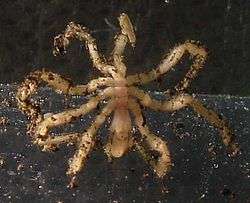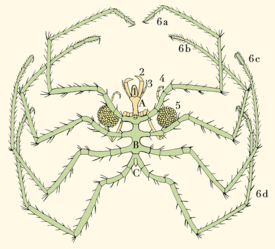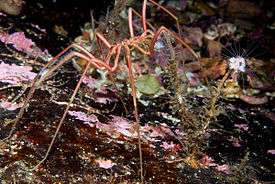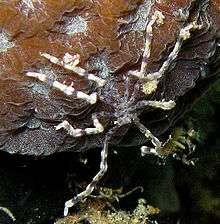Sea spider
| Sea Spider Temporal range: Late Cambrian–Recent | |
|---|---|
 | |
| Scientific classification | |
| Kingdom: | Animalia |
| Phylum: | Arthropoda |
| Subphylum: | Chelicerata |
| Class: | Pycnogonida Latreille, 1810 |
| Order: | Pantopoda Gerstaecker, 1863 |
| Families | |
| |
Sea spiders, also called Pantopoda or pycnogonids, ('pycno-' closely packed, 'gonid' gonidia) are marine arthropods of class Pycnogonida.[1] They are cosmopolitan, found especially in the Mediterranean and Caribbean Seas, as well as the Arctic and Antarctic Oceans. There are over 1300 known species, ranging in size from 1 millimetre (0.039 in) to over 90 cm (35 in) in some deep water species. Most are toward the smaller end of this range in relatively shallow depths, however, they can grow to be quite large in Antarctic waters.
Although "sea spiders" are not true spiders, or even arachnids, their traditional classification as chelicerates would place them closer to true spiders than to other well-known arthropod groups, such as insects or crustaceans. However even this is in dispute, as genetic evidence suggests they may even be an ancient sister group to all other living arthropods.[2][3]
Description

Sea spiders have long legs in contrast to a small body size. The number of walking legs is usually eight (four pairs), but species with five and six pairs exist. Because of their small size and thin body and legs, no respiratory system is necessary, with gases moving by diffusion. A proboscis allows them to suck nutrients from soft-bodied invertebrates, and their digestive tract has diverticula extending into the legs.

Pycnogonids are so small that each of their tiny muscles consists of only one single cell, surrounded by connective tissue. The anterior region consists of the proboscis, which has fairly limited dorsoventral and lateral movement, and three to four appendages including the ovigers, which are used in caring for young and cleaning as well as courtship. In some species, the chelifores, palps and ovigers can be reduced or missing in adults. In those species that lack chelifores and palps, the proboscis is well developed and more mobile and flexible, often equipped with numerous sensory bristles and strong rasping ridges around the mouth. The last segment includes the anus and tubercle, which projects dorsally.
In total, pycnogonids have four to six pairs of legs for walking as well as other appendages which often resemble legs. A cephalothorax and much smaller abdomen make up the extremely reduced body of the pycnogonid, which has up to two pairs of dorsally located simple eyes on its non-calcareous exoskeleton, though sometimes the eyes can be missing, especially among species living in the deep oceans. The abdomen does not have any appendages, and in most species it is reduced and almost vestigial. The organs of this chelicerate extend throughout many appendages because its body is too small to accommodate all of them alone.
The morphology of the sea spider creates an extremely well suited surface-area to volume ratio for any respiration to occur through direct diffusion. The most recent research seems to indicate that waste leaves the body through the digestive tract or is lost during a moult. The small, long, thin pycnogonid heart beats vigorously at 90 to 180 beats per minute, creating substantial blood pressure. These creatures possess an open circulatory system as well as a nervous system consisting of a brain which is connected to two ventral nerve cords, which in turn connect to specific nerves.
Reproduction and development
All pycnogonid species have separate sexes except for one species that is hermaphroditic. Females possess a pair of ovaries, while males possess a pair of testes located dorsally in relation to the digestive tract. Reproduction involves external fertilisation after “a brief courtship”. Only males care for laid eggs and young.
The larva has a blind gut and the body consist literally of a head and its three pairs of cephalic appendages only: the chelifores, palps and ovigers. The abdomen and the thorax with its thoracic appendages develop later. One theory is that this reflects how a common ancestor of all arthropods evolved; starting its life as a small animal with a pair of appendages used for feeding and two pairs used for locomotion, while new segments and segmental appendages were gradually added as it was growing.
At least four types of larvae have been described: the typical protonymphon larva, the encysted larva, the atypical protonymphon larva, and the attaching larva. The typical protonymphon larva is most common, is free living and gradually turns into an adult. The encysted larva is a parasite that hatches from the egg and finds a host in the shape of a polyp colony where it burrows into and turns into a cyst, and will not leave the host before it has turned into a young juvenile.
Not much is known about the development of the atypical protonymphon larva. The adults are free living, while the larvae and the juveniles are living on or inside temporary hosts such as polychaetes and clams. When the attaching larva hatches it still looks like an embryo, and immediately attaches itself to the ovigerous legs of the father, where it will stay until it has turned into a small and young juvenile with two or three pairs of walking legs ready for a free-living existence.
Distribution and ecology

These small animals live in many different parts of the world, from Australia, New Zealand, and the Pacific coast of the United States, to the Mediterranean Sea and the Caribbean Sea, to the north and south poles. They are most common in shallow waters, but can be found as deep as 7,000 metres (23,000 ft), and live in both marine and estuarine habitats. Pycnogonids are well camouflaged beneath the rocks and among the algae that are found along shorelines.
Sea spiders either walk along the bottom with their stilt-like legs or swim just above it using an umbrella pulsing motion.[4] Most are carnivorous and feed on cnidarians, sponges, polychaetes and bryozoans. Sea spiders are generally predators or scavengers. They will often insert their proboscis, a long appendage used for digestion and sucking food into its gut, into a sea anemone and suck out nourishment. The sea anemone, large in comparison to its predator, almost always survives this ordeal.
Classification
The class Pycnogonida comprises over approximately 1,300 species, which are normally split into eighty-six genera. The correct taxonomy within the group is uncertain, and it appears that no agreed list of orders exists. Accordingly, families are listed in the taxobox, all considered part of the single order Pantopoda.
Sea spiders have long been considered to belong to the Chelicerata, together with horseshoe crabs, and the Arachnida, which includes spiders, mites, ticks, scorpions, and harvestmen, among other, lesser known orders.[5]
Another idea is that they belong to their own lineage, distinct from chelicerates, crustaceans, myriapods, or insects. The reason for this is that it seems the appendages called chelifores are unique among extant arthropods, and are not homologous to the chelicerae in real chelicerates as previously supposed. Instead of developing from the deutocerebrum, they can be traced to the protocerebrum, the anterior part of the arthropod brain and found in the first head segment that in all other arthropods give rise to the eyes only. This is not found anywhere else among arthropods except in some fossil forms like Anomalocaris, indicating that the Pycnogonida may be a sister group to all other living arthropods, the latter having evolved from some ancestor that had lost the protocerebral appendages. If this is confirmed, it would mean the sea spiders are the last surviving (and highly modified) members of an ancient stem group of arthropods that lived in Cambrian oceans.[6] However, a subsequent study using Hox gene expression patterns consistent with a developmental homology between chelicerates and chelifores, with chelifores innervated from a deuterocerebrum that has been rotated forwards; thus, the protocerebral Great Appendage clade does not include the Pycnogonida.[7][8]
Recent work places the Pycnogonida outside the Arachnomorpha as basal Euarthropoda, or inside Chelicerata (based on the chelifore-chelicera putative homology).[9]
Fossil record
Although the fossil record of pycnogonids is scant, it is clear that they once possessed a coelom, but it was later lost, and that the group is very old.
The earliest fossils are known from the Cambrian 'Orsten' of Sweden, the Silurian Wenlock Series of England and the Devonian Hunsrück Slate of Germany. Some of these specimens are significant in that they possess a longer 'trunk' behind the abdomen and in two fossils the body ends in a tail; something never seen in living sea spiders.
In 2007 remarkably well preserved fossils were exposed in fossil beds at La Voulte-sur-Rhône, south of Lyon in south-eastern France. Researchers from the University of Lyon discovered about 70 fossils from three distinct species in the 160-million-year-old Jurassic La Voulte Lagerstätte. The find will help fill in an enormous gap in the history of these creatures.[10]
References
- ↑ "WoRMS taxon details - Pycnogonida". World Register of Marine Species. Retrieved 27 March 2015.
- ↑ Regier, Jerome C.; Shultz, Jeffrey W.; Zwick, Andreas; Hussey, April; Ball, Bernard; Wetzer, Regina; Martin, Joel W.; Cunningham, Clifford W. (2010). "Arthropod relationships revealed by phylogenomic analysis of nuclear protein-coding sequences". Nature 463 (7284): 1079–83. Bibcode:2010Natur.463.1079R. doi:10.1038/nature08742. PMID 20147900.
- ↑ Sharma, P. P.; Kaluziak, S. T.; Perez-Porro, A. R.; Gonzalez, V. L.; Hormiga, G.; Wheeler, W. C.; Giribet, G. (2014). "Phylogenomic Interrogation of Arachnida Reveals Systemic Conflicts in Phylogenetic Signal". Molecular Biology and Evolution 31 (11): 2963–84. doi:10.1093/molbev/msu235. PMID 25107551.
- ↑ Deep-Sea News: Sea Spiders
- ↑ Margulis, Lynn; Schwartz, Karlene (1998). Five Kingdoms, An Illustrated Guide to the Phyla of Life on Earth (third ed.). W.H. Freeman and Company. ISBN 0-7167-3027-8.
- ↑ Maxmen, Amy; Browne, William E.; Martindale, Mark Q.; Giribet, Gonzalo (2005). "Neuroanatomy of sea spiders implies an appendicular origin of the protocerebral segment". Nature 437 (7062): 1144–8. Bibcode:2005Natur.437.1144M. doi:10.1038/nature03984. PMID 16237442.
- ↑ Jager, Muriel; Murienne, Jérôme; Clabaut, Céline; Deutsch, Jean; Guyader, Hervé Le; Manuel, Michaël (2006). "Homology of arthropod anterior appendages revealed by Hox gene expression in a sea spider". Nature 441 (7092): 506–8. Bibcode:2006Natur.441..506J. doi:10.1038/nature04591. PMID 16724066.
- ↑ Pharyngula
- ↑ Dunlop, J. A.; Arango, C. P. (2005). "Pycnogonid affinities: A review". Journal of Zoological Systematics and Evolutionary Research 43: 8–21. doi:10.1111/j.1439-0469.2004.00284.x.
- ↑ "Fossil sea spiders thrill experts". BBC News. August 16, 2007.
External links
 Data related to Pycnogonida at Wikispecies
Data related to Pycnogonida at Wikispecies Media related to Pycnogonida at Wikimedia Commons
Media related to Pycnogonida at Wikimedia Commons- PycnoBase: World list of Pycnogonida
- Introduction to the Pycnogonida
- Images of Pycnogonida, and Pycnogonids in literature
- Bibliography (compiled by Franz Krapp)
- Macrobenthos of the North sea, Pycnogonida
| ||||||||||||||||||||||||||||||||||||||||||||||||||||||||||||||||||||||||||||||||||